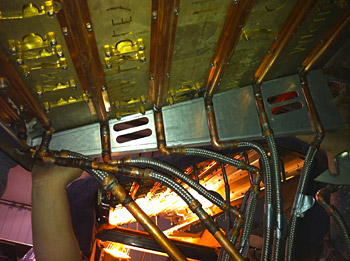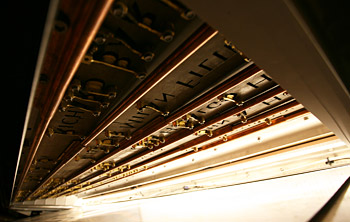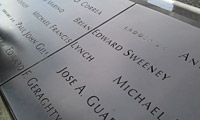9/11 Memorial – A Look Inside
The National September 11 Memorial is a beacon of human compassion and a place of remembrance for those touched by the tragic events that occurred in lower Manhattan more than a decade ago.
 Copper tubing at the 9/11 Memorial.
Copper tubing at the 9/11 Memorial.Photo credit: Ronaldo Vega
High-resolution version of this photo.
In the footprints of where the twin towers once stood sit two rectangular, reflective pools. Measuring close to an acre each and 45 feet in depth, the pools serve as the base of North America’s largest manmade waterfalls. Every minute, 50,000 gallons of recycled water slowly surge over the lip of the waterfall ledge creating sheets of cascading water. A total of 152 connecting bronze panels engraved with the 2,983 names of the victims, including 11 unborn children, surround the two pools and their respective waterfalls.
The memorial is a modern marvel in its outward appearance, but it’s the infrastructure that gives this landmark its special “touch.” Physical contact with the memorial is encouraged. Millions of people are expected to visit each year to walk the grounds and pay their respects by tracing the names on the panels with their fingers. Most of these visitors won’t see the miles of copper pipes beneath the bronze surfaces, which warm the panels in the winter and cool them in the summer.
 A look underneath the Memorial's panels.
A look underneath the Memorial's panels.Photo credit: Amy Dreher
High-resolution version of this photo.
The system was designed by Jaros Baum & Boles (JB&B) of New York and KC Fabrications of Gardiner, NY. It consists of approximately 12,000 feet of copper brackets and 14,000 feet of copper piping. Christopher Powers, founder of KC Fabrications, worked with JB&B to design the system and ensure it would work with their bronze parapets.
“We worked together to design and assemble a back-mounted tube system that could work within the parapets and nameplate system,” said Powers. “A network of copper pipes circulates glycol behind the parapets to heat and cool the bronze panels.”
Half-inch diameter copper tubing makes this heating and cooling possible. Tubing is fastened behind each panel in a looping system down into the pedestal, thereby controlling the temperature of the touch surfaces. Keeping the panels between 40 and 70 degrees Fahrenheit is essential for the Memorial’s success. If the panels are too hot or too cold, the Memorial loses the ability for people to interact with it.
Because of its corrosion resistance, high levels of heat transfer, durability, workability and reliability, copper was the preferred material choice for this project.
Ronaldo Vega, New York native and the Memorial’s Director of Design and Construction, believes that human interaction with the Memorial is vital for every visitor’s experience.
“The bronze panels are the first thing people see, the first thing they touch, and their first contact with the Memorial,” said Vega. “We want people to be able to connect with it. The Memorial almost becomes like a baptismal setting. Here folks can dip their hand in the water beneath the panel and leave a hand print instead of a stone or rock.”
The project, which is Gold LEED certified, also uses recycled water for the waterfalls and to irrigate the nearly 400 trees that have been planted on site.
“The system is extremely efficient,” said Vega. “It was designed to minimize water and energy costs.”
Andy Kireta, Sr., president of the Copper Development Association (CDA), said he was impressed by the amount of copper used at the site, which visitors would be able to see firsthand. With about 91 tons of bronze in the panels and miles of brackets and tubing, copper and its alloys shine as the Memorial’s most vital performers.
“From the piping to the panels, copper plays a key role in making this Memorial truly unforgettable,” said Kireta, during a recent visit to the hallowed grounds. “To be here and to see it in person is a remarkable experience. Hopefully, this magnificent memorial can serve as a lasting tribute and help heal the families who were directly affected as well as our country.” Cu
Also in this Issue:
- 9/11 Memorial – A Look Inside
- Upgrade at Ronald McDonald House Keeps Families Connected
- Dali Museum Wows with Immersive Art Experience
- A New Timepiece for Bradley U.

 9/11 Memorial bronze panels.
9/11 Memorial bronze panels.